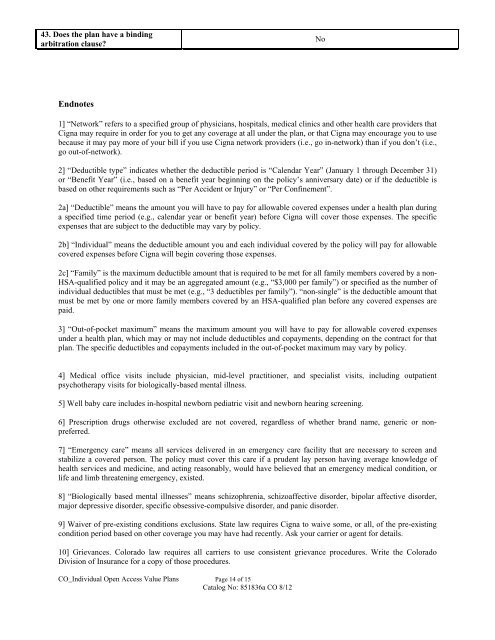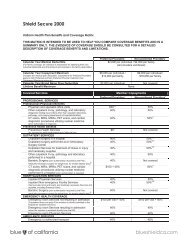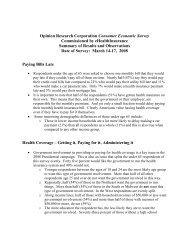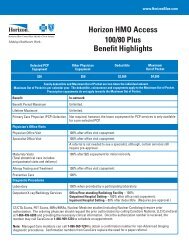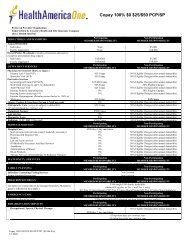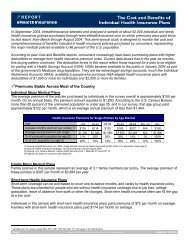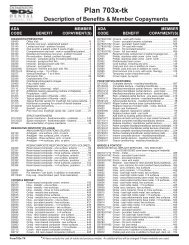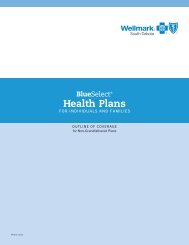COLORADO HEALTH PLAN DESCRIPTION FORM - Cigna
COLORADO HEALTH PLAN DESCRIPTION FORM - Cigna
COLORADO HEALTH PLAN DESCRIPTION FORM - Cigna
You also want an ePaper? Increase the reach of your titles
YUMPU automatically turns print PDFs into web optimized ePapers that Google loves.
43. Does the plan have a bindingarbitration clause?NoEndnotes1] “Network” refers to a specified group of physicians, hospitals, medical clinics and other health care providers that<strong>Cigna</strong> may require in order for you to get any coverage at all under the plan, or that <strong>Cigna</strong> may encourage you to usebecause it may pay more of your bill if you use <strong>Cigna</strong> network providers (i.e., go in-network) than if you don’t (i.e.,go out-of-network).2] “Deductible type” indicates whether the deductible period is “Calendar Year” (January 1 through December 31)or “Benefit Year” (i.e., based on a benefit year beginning on the policy’s anniversary date) or if the deductible isbased on other requirements such as “Per Accident or Injury” or “Per Confinement”.2a] “Deductible” means the amount you will have to pay for allowable covered expenses under a health plan duringa specified time period (e.g., calendar year or benefit year) before <strong>Cigna</strong> will cover those expenses. The specificexpenses that are subject to the deductible may vary by policy.2b] “Individual” means the deductible amount you and each individual covered by the policy will pay for allowablecovered expenses before <strong>Cigna</strong> will begin covering those expenses.2c] “Family” is the maximum deductible amount that is required to be met for all family members covered by a non-HSA-qualified policy and it may be an aggregated amount (e.g., “$3,000 per family”) or specified as the number ofindividual deductibles that must be met (e.g., “3 deductibles per family”). “non-single” is the deductible amount thatmust be met by one or more family members covered by an HSA-qualified plan before any covered expenses arepaid.3] “Out-of-pocket maximum” means the maximum amount you will have to pay for allowable covered expensesunder a health plan, which may or may not include deductibles and copayments, depending on the contract for thatplan. The specific deductibles and copayments included in the out-of-pocket maximum may vary by policy.4] Medical office visits include physician, mid-level practitioner, and specialist visits, including outpatientpsychotherapy visits for biologically-based mental illness.5] Well baby care includes in-hospital newborn pediatric visit and newborn hearing screening.6] Prescription drugs otherwise excluded are not covered, regardless of whether brand name, generic or nonpreferred.7] “Emergency care” means all services delivered in an emergency care facility that are necessary to screen andstabilize a covered person. The policy must cover this care if a prudent lay person having average knowledge ofhealth services and medicine, and acting reasonably, would have believed that an emergency medical condition, orlife and limb threatening emergency, existed.8] “Biologically based mental illnesses” means schizophrenia, schizoaffective disorder, bipolar affective disorder,major depressive disorder, specific obsessive-compulsive disorder, and panic disorder.9] Waiver of pre-existing conditions exclusions. State law requires <strong>Cigna</strong> to waive some, or all, of the pre-existingcondition period based on other coverage you may have had recently. Ask your carrier or agent for details.10] Grievances. Colorado law requires all carriers to use consistent grievance procedures. Write the ColoradoDivision of Insurance for a copy of those procedures.CO_Individual Open Access Value Plans Page 14 of 15Catalog No: 851836a CO 8/12


